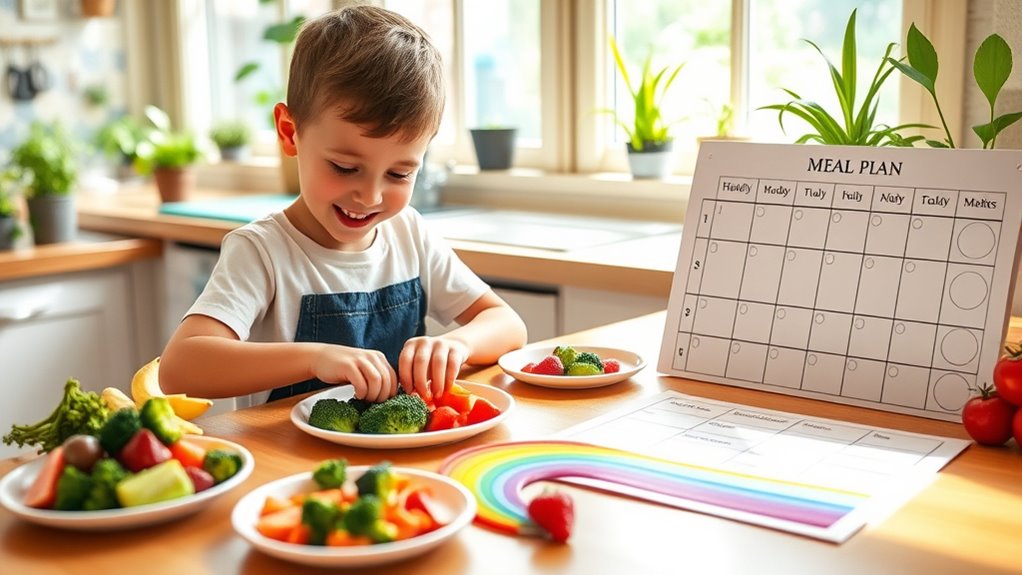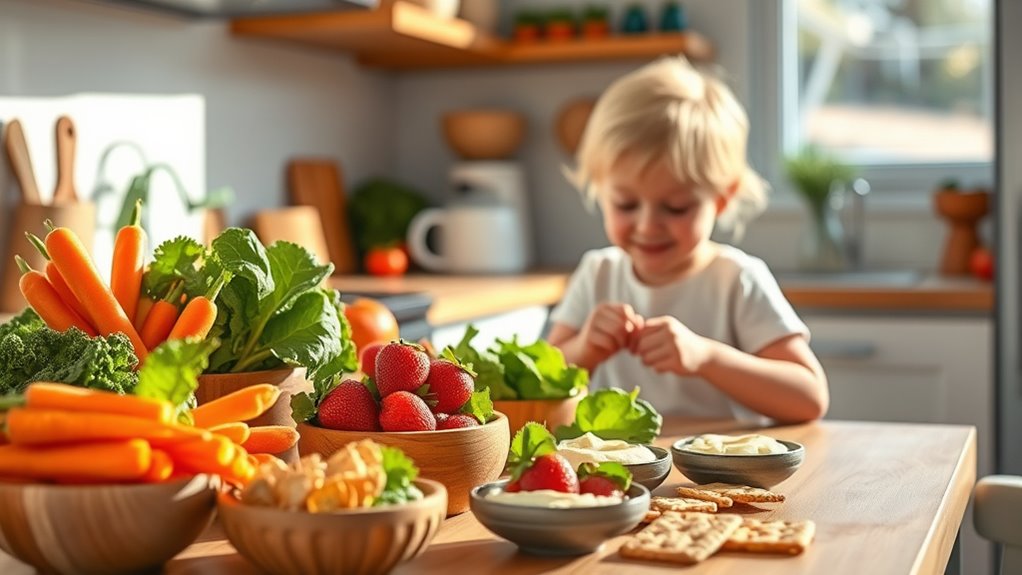To encourage healthy eating habits in growing kids, focus on a balanced diet with fruits, vegetables, whole grains, lean proteins, and healthy fats. Create a pleasant eating environment by making mealtimes enjoyable and routine. Involve your kids in meal planning and preparation to spark their interest. Encourage them to appreciate food through mindfulness and gratitude. Helping them recognize hunger cues supports a healthy relationship with food. There are more tips to help you foster these habits effectively.
Key Takeaways
- Include a variety of fruits, vegetables, whole grains, lean proteins, and healthy fats to ensure balanced nutrition for growing kids.
- Involve children in meal planning and preparation to increase their interest in healthy food choices.
- Establish regular mealtimes in a calm environment to support digestive health and foster healthy eating habits.
- Encourage mindfulness by helping kids recognize hunger and fullness cues, promoting a healthy relationship with food.
- Educate children about nutrition and food sources to empower them to make informed food choices.
Building a Balanced Diet for Kids

When you’re working to build a balanced diet for your kids, it’s vital to include a variety of food groups that provide the nutrients they need for healthy growth.
Start with fruits and vegetables, which are packed with vitamins and fiber. Incorporate whole grains for energy and additional fiber. Lean proteins like chicken, fish, and beans support muscle development, while dairy products offer calcium for strong bones. A variety of foods is essential to ensure they receive all the necessary nutrients for their growth. Additionally, including sources of essential fatty acids can further support their overall health and development. Consuming a balanced diet helps in establishing healthy eating habits early on. Including healthy fats in their meals can also aid in cognitive function and overall well-being, as well as provide protein-rich options that contribute to sustained energy levels. For example, foods like avocado toast are not only delicious but also rich in nutrients that can enhance their diet.
Include a mix of fruits, vegetables, whole grains, lean proteins, and dairy for your kids’ balanced diet.
Don’t forget healthy fats from sources like avocados and nuts, which are essential for brain development. Aim for variety in meals and limit processed foods.
Encourage your kids to help with meal prep, making them more likely to try new foods. Finally, make sure they stay hydrated with plenty of water throughout the day.
Creating Healthy Eating Environments

Creating a healthy eating environment is essential for fostering good nutritional habits in kids. Start by structuring family meals as enjoyable, predictable occasions. Keep healthy foods like fruits and vegetables visible and accessible, while limiting unhealthy snacks to reduce their appeal. Involve your children in meal preparation; this can spark their interest in trying new foods. Additionally, remember that repeated exposure is key; kids may need 10-15 tries to accept new foods. Establish routine mealtimes to support digestive health and maintain energy levels. Encourage a calm, distraction-free atmosphere during meals to help regulate appetite. Furthermore, establishing healthy boundaries around food choices can empower children to make better decisions. Children who grow up with emotional stability are more likely to develop a positive relationship with food. A well-balanced diet can also help prevent issues such as gout symptoms that may arise from poor nutrition. Regular engagement in physical activity is also critical for maintaining a healthy weight and overall well-being. Moreover, teaching children about budgeting can instill valuable financial habits related to food spending.
Remember to model healthy eating habits yourself, as kids often mimic what they see. By creating a positive food environment, you’ll nurture their relationship with food and set the foundation for lifelong healthy eating habits.
Fostering Healthy Eating Habits

How can you effectively foster healthy eating habits in your kids? Start by modeling healthy behavior; when they see you enjoying fruits and vegetables, they’re more likely to follow suit.
Involve them in meal planning and preparation, making them feel invested in their food choices. Promote balanced diets by offering a variety of foods, including lean proteins and whole grains, without labeling anything as “bad.” Practicing mindfulness around food choices can also enhance their appreciation of healthy eating, as it encourages them to recognize the nutritional advantages of different foods. Additionally, consider including recommended feeding options for balanced nutrition, which can help guide their food choices. Including vegetarian options like baked kale can also introduce them to nutritious foods packed with vitamins and minerals. Introducing chia seeds into meals can provide essential nutrients while supporting their growth.
Encourage self-feeding to help them develop independence and listen to their hunger cues. Create a positive mealtime atmosphere, and avoid forcing food on them. Set regular meal and snack times to help establish a routine that supports healthy eating habits.
Instead, praise their efforts to try new things, fostering a sense of accomplishment and curiosity about healthy foods. This way, you’ll lay the foundation for lifelong healthy eating habits.
Implementing Structured Meal Plans

Fostering healthy eating habits lays the groundwork for implementing structured meal plans that support your child’s growth.
Start by ensuring meals include balanced nutrition with proteins, complex carbohydrates, healthy fats, fruits, and vegetables. Offer a variety of foods to keep mealtime interesting and prevent picky eating. Serve age-appropriate portion sizes, and establish regular mealtimes to help regulate your child’s appetite. Aim for a wide range of foods to prevent picky eating and encourage diverse healthy options. Including lean proteins in your meals, such as chicken or fish, is essential for muscle development. Additionally, introducing beetroot recipes can enhance meals with nutritious options that appeal to your child’s taste. Utilizing essential oils like lemon can also add flavor to meals without added sugar or salt, making food more enjoyable. Incorporating educational toys can help engage your child in learning about nutrition while they play. Moreover, regular physical activity helps to promote overall health and complements a balanced diet for optimal growth.
Ensure meals provide balanced nutrition with proteins, carbs, healthy fats, and a variety of fruits and vegetables to engage your child.
Incorporate whole grains like brown rice and quinoa for added fiber. Planning meals ahead can streamline shopping and prep, making it easier to stick to healthy choices.
Involving your child in meal planning can also boost their interest in nutritious foods. This structured approach sets the stage for lifelong healthy eating habits.
Promoting Active Involvement in Food Choices

Why not involve your kids in the food choices you make as a family? Engaging them in meal preparation not only helps them appreciate healthy foods but also increases their willingness to try new ones. Assign age-appropriate kitchen tasks to boost their confidence and understanding of nutrition. When you let them choose fruits and vegetables at the store, you encourage active decision-making about healthy eating. Leading by Example can further enhance their motivation to adopt healthy habits, as they see you prioritizing nutritious choices. Educate them about reading food labels to enhance their awareness of what they consume. Involving kids in meal planning can further deepen their connection to food. Additionally, teaching them about the importance of nutrition can empower them to make informed food choices as they grow. Moreover, fostering open communication about their food preferences can help them articulate their needs and develop a healthier relationship with food. For instance, discussing various sleep training methods can help them understand the role of nutrition in overall health and well-being, leading to more informed choices at the table. Furthermore, introducing them to organic farming methods can provide a practical context for understanding where their food comes from and the benefits of healthy eating.
Managing Challenges and Picky Eating

Involving your kids in food choices and meal prep can make a significant difference when it comes to managing challenges like picky eating. Since around 50% of children are picky eaters, offering a variety of foods, especially fruits and vegetables, is essential.
Try modeling positive food behavior by eating new foods yourself; this can encourage your child to join in. When you involve them in meal planning and grocery shopping, their interest in trying different foods often increases. Additionally, consider using essential oil safety practices to create a pleasant eating environment, as certain scents can influence appetite and mood.
Encouraging Mindful Eating Practices

How can you help your kids develop a healthy relationship with food? Start by encouraging mindful eating practices. Teach them to be present during meals, focusing on their thoughts and feelings without judgment.
This awareness helps them recognize hunger and fullness cues, reducing stress-related eating. Create a calm environment free from distractions like TVs or phones to enhance their sensory experience.
Involve them in meal preparation and encourage gratitude before eating. Use activities like sensory explorations, tasting stations, and slow bites to deepen their connection to food.
Frequently Asked Questions
How Can I Deal With Food Allergies in Kids?
Dealing with food allergies in kids can be challenging, but you can manage it effectively. Start by identifying allergens through observation and consulting a doctor for testing.
Always read food labels carefully and prepare meals at home to control ingredients. Educate your child about their allergies, so they understand the importance of avoiding certain foods.
Keep a well-stocked emergency kit with antihistamines or an epinephrine auto-injector, and communicate with teachers and caregivers about their needs.
What Snacks Are Best for After-School Energy?
To fuel your after-school energy, opt for snacks that combine nutrients effectively.
Try apple slices with peanut butter for a tasty mix of carbohydrates, healthy fats, and protein.
Greek yogurt with berries and granola offers a quick energy boost, while hummus with veggie sticks provides plant-based protein and fiber.
You can also prepare trail mix with nuts and dried fruits for a convenient, energizing option.
Keep snacks balanced and varied to maintain energy levels!
How Do I Read Nutrition Labels Effectively?
To read nutrition labels effectively, start by checking the serving size and servings per container.
Look at calories and key nutrients like total fat and sugars. Use the % Daily Value to gauge how a food fits into your daily intake.
Pay attention to the ingredients list, opting for whole foods at the top.
Finally, compare similar products using the per 100g column for a clearer understanding of nutritional content.
What Are Healthy Dessert Options for Children?
When considering healthy dessert options for kids, think about incorporating natural sweeteners like honey or maple syrup instead of refined sugars.
You can make fruit salads or baked apples with cinnamon for a nutritious treat. Get creative with veggie-infused desserts like zucchini bread or carrot cake.
Homemade fruit snacks or no-bake energy bites are also great choices. Engaging your children in preparing these desserts makes it fun and educational, promoting healthier habits.
How Can I Encourage Kids to Drink More Water?
To encourage kids to drink more water, make it fun and engaging. Use colorful cups or fun straws to spark their interest.
Let them choose their own water bottles and get involved in making infused water with their favorite fruits.
Establish a hydration routine, incorporating water breaks during playtime or meals.
Celebrate their progress with rewards and make drinking water a family activity, so they see you modeling healthy habits.
Conclusion
Incorporating healthy eating habits for your growing kids is like planting a garden; with care and attention, you’ll nurture their bodies and minds to flourish. By building a balanced diet, creating inviting meal environments, and fostering mindful eating practices, you lay the foundation for a lifetime of healthy choices. Remember, it’s a journey, not a sprint, so stay patient and positive as you cultivate their relationship with food. Watch them thrive as they grow strong and healthy!









